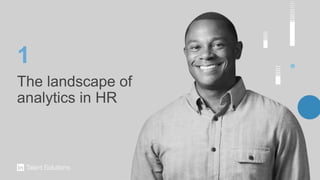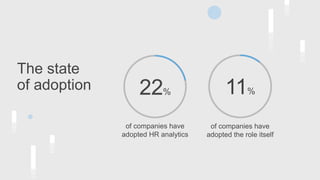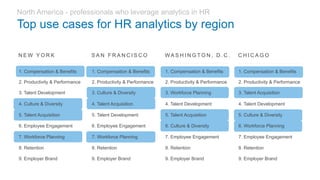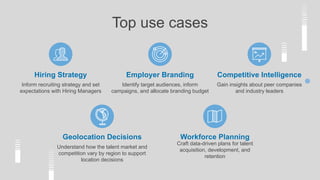4 Steps to Become an HR Analytics Champion
- 1. 4 steps to becoming an HR analytics champion How talent leaders are using data in the era of talent intelligence
- 2. Meet your speakers David Green People Analytics Leader Sarah O’Brien Global Insights DirectorDirector Insight222, People Analytics & Future of Work Co- Chair LinkedIn Talent Solutions
- 3. Before we get started Everyone is muted by default Submit questions; Q&A session to follow Please share feedback in survey after session We’ll share a recording of the webinar via email
- 4. Agenda Understand the landscape of analytics in HR Learn how early adopters are leveraging data & insights Discover how to build a data-driven culture Applying analytics to answer critical talent questions 1 2 3 4
- 5. The landscape of analytics in HR 1
- 6. Analytics is on the rise In the last five years in North America, there has been a 3x increase in HR professionals who list analytics skills and keywords on their profiles. Top skills
- 7. 61% Increase (2017-18) in the number of people in EMEA with HR Analytics listed as a skill on their LinkedIn profile EMEA 70% Increase (2014-18) in the number of specialized HR Analytics professionals in APAC APAC
- 8. What’s behind the rise of analytics? The growth in HR tech and innovation 1 2 3 The CEO’s relationship with the CHRO An increasingly competitive landscape
- 9. 22% of companies have adopted HR analytics of companies have adopted the role itself 11% The state of adoption
- 10. % of companies applying analytics in HR by industry North America - All companies with HR Companies leveraging analytics in HR Companies with dedicated HR analytics roles Retail & Consumer Products Technology - Hardware Healthcare & Pharmaceuticals Oil & Energy Financial Services Technology - Software 10% 20% 30%
- 11. How early adopters are leveraging data 2
- 12. Top use cases for HR analytics by region North America - professionals who leverage analytics in HR 1. Compensation & Benefits 1. Compensation & Benefits 1. Compensation & Benefits 2. Productivity & Performance 2. Productivity & Performance 2. Productivity & Performance 3. Talent Development 3. Culture & Diversity 3. Workforce Planning 4. Culture & Diversity 4. Talent Acquisition 4. Talent Development 5. Talent Acquisition 5. Talent Development 5. Talent Acquisition 6. Employee Engagement 6. Employee Engagement 6. Culture & Diversity 7. Workforce Planning 7. Workforce Planning 7. Employee Engagement 8. Retention 8. Retention 8. Retention 9. Employer Brand 9. Employer Brand 9. Employer Brand N E W Y O R K S A N F R A N C I S C O WA S H I N G T O N , D . C . 1. Compensation & Benefits 2. Productivity & Performance 3. Talent Acquisition 4. Talent Development 5. Culture & Diversity 6. Workforce Planning 7. Employee Engagement 8. Retention 9. Employer Brand C H I C A G O
- 13. How to build a data-driven culture 3
- 14. Consulting Structuring an HR data analytics team Data Talent Portal (self-service) Scalable and Repeatable Visualizations Data Modeling and Structure Research Deep Competitive Insights Artificial Intelligence/Machine Learning Longitudinal Research Single Point Contacts for HR Leadership Team Line of Business & Center of Excellence Consulting, Analysis & Insights Building an Insights-Driven Culture
- 15. Recruiting and Placement Sourcing Compensation and Benefits Payroll, Benefits negotiation Other HR Domain Skills Talent Management, Employee Engagement, Employer Branding, Workforce Planning, Employee Training, Organizational Development H R D O M A I N Statistical Analysis and Data Mining Business Intelligence Big Data and Machine Learning Market Research and Insights HR Software Data Engineering and Data Warehousing Database Management & Software D ATA A N A LY T I C S Business Development and Relationship Management Strategy and Strategic Planning Business Analysis Management and Leadership S T R AT E G Y
- 16. Communicate the purpose, value, and benefit of analytics in HR Create a culture of learning Hire for analytical capability 1 2 3 How to build a data-driven culture in HR
- 17. Applying analytics to answer critical talent questions 4
- 18. Which companies are you gaining talent from and losing talent to? What skills will your company need in the future? Where should you open your next office? 1 2 3 Questions to ask yourself
- 19. LinkedIn Talent Insights a new, self-service product that gives you access to real-time data and insights on talent pools and companies around the world. Make smarter decisions with talent pool insights Gain a competitive advantage with company insights Elevate the role of talent within your organization
- 21. Hiring Strategy Inform recruiting strategy and set expectations with Hiring Managers Top use cases Employer Branding Identify target audiences, inform campaigns, and allocate branding budget Geolocation Decisions Understand how the talent market and competition vary by region to support location decisions Workforce Planning Craft data-driven plans for talent acquisition, development, and retention Competitive Intelligence Gain insights about peer companies and industry leaders
- 22. Demo time
- 23. Questions?
- 24. Key takeaways Start with the business challenge, not the data Analytics is a team sport: leverage resources and data from outside HR Get a sponsor for every analytics project 1 2 3
- 25. Thank you.
Editor's Notes
- DAVID: Welcome to our webcast: 4 steps to becoming an HR analytics champion! We’re so excited to have you join us today. I’m David Green and… ((David to share intro, 45s) SARAH: My name is Sarah O’Brien, and I lead LinkedIn’s global insights capability. My team is responsible for leveraging LinkedIn’s data to help companies acquire and develop talent and grow their businesses. With 590M members and 30M companies now on LinkedIn, our data provides a window into patterns in the talent marketplace: talent migration, emerging skills, competitive talent flows, and more. Many of the insights created by my team have been developed into our new self-serve analytics offering, Talent Insights, which you will hear about later. Prior to LinkedIn, I played leadership roles in the Advanced Analytics practice and the Tech, Media Telcom practice at Bain & Company, a strategy consulting firm, where I helped companies across the world become data-driven organizations.
- SARAH: Before we dive in, let’s go over a few housekeeping items. Everyone’s microphones are muted by default. We want to hear your questions, thoughts, and comments though, so be sure to submit your questions in the Q&A window on the left side of your webcast window. We’ll try to answer as many questions as we can during the Q&A session at the end of the webcast. At LinkedIn, we consider feedback a gift, so feel free to share your feedback in the survey console after the session. It’s a quick survey and we read all the responses! Your feedback helps curate even better content for you in the future. Finally, we’ll be sharing out the recording and slides after the webcast so you can view and share with your team and colleagues as you like. Should you have any technical issues during the webcast, use the chat feature and our team will work to fix it. With all that covered, let’s get started.
- DAVID: The need for high-performing talent has never been greater, so it’s become more important than ever to leverage data in human resources. But building a data-driven function across every dimension of HR – from talent acquisition, performance, and workforce planning to workplace policies, employee engagement, and retention – can be complex and challenging. SARAH: Exactly. And That’s why earlier this year, LinkedIn conducted in-depth research sessions and discussions with top HR leaders in industries like retail, tech, finance, and government all across the globe to try and tackle those questions that come up when your team is trying to ramp your own talent analytics capabilities. In this webcast, we’re sharing these findings, including everything from the the state of adoption to how to answer your toughest talent questions with data & analytics. We’ll start with a broader look at the rate of adoption of talent analytics – where we’ll cover why we’re seeing such a significant rise in the last few years. We’ll also discuss how early adopters are using data and insights for both traditional and more unique use cases. Then we’ll outline what you can do to build a data-driven culture in your organization. Lastly, we’ll cover how you can apply analytics to answer talent questions like “where should you open your next office?”
- DAVID: Thanks, Sarah. Now we’ll get into the meat of it: what does the landscape of analytics in HR looks like.
- DAVID: One thing we want to highlight off the bat is that conversations about applying data analytics to HR management aren’t new. The reality is one of themost important assets in a company are its people data. Despite more than a decade of discussion, organizations are at different maturity levels when it comes to people analytics adoption. Even though analytics has been on HR leaders’ minds for quite some time, it’s only in the last five years that we’ve seen a 3x increase in HR professionals who list analytic skills and keywords on their LinkedIn profiles. While many HR professionals leverage analytics as part of their general HR role, an increasing number focus primarily on HR analytics. These specialists work on teams with names like “talent analytics” and “people analytics” at a number of the larger, more forward-thinking enterprise companies.
- DAVID: We’re also seeing as similar pattern of rapid growth globally. In EMEA, we’re seeing a 61% increase in the last year of talent professionals with HR analytics on their LinkedIn profiles. In APAC, that number is even higher with a 70% increase in HR analytics as a skill. All of these trends are a signal that we’ve reached a tipping point with people analytics– it’s only going to become more and more integrated to the way HR teams are building their strategies. But as we’ve already mentioned, this trend isn’t completely new. What is new is the rate of growth is. So what’s behind that growth, and why now? And how is it impacting the way organizations are leveraging people analytics?
- DAVID: The first driver of this growth is the relationship between your CEO and CHRO. Key questions on talent are top of mind for CEO’s, now more than ever. According to the PWC CEO survey, over 77% of CEOs believe that the biggest threat to their business is the lack of availability of key skills. With CEOs so concerned about talent, it’s on talent teams and CHROs to help plan for the workforce of the future. As many of you know, when you’re trying to develop your retention strategy, build a pipeline of stellar candidates, and find that key hire that could transform your business, you want to use everything in your toolbelt. HR data analytics can help answer many of the critical concerns CHROs must grapple with, including workforce diversity, geolocation decisions, hiring strategy, competitive benchmarking, workforce planning, and employer branding. SARAH: The second driver of talent analytics adoption is the growth of HR tech and innovation. We’re starting to see that the traditional tech challenges for accessing data are starting to go away. In the past, it was much more difficult to get data – especially the relevant data you needed to answer the questions you cared most about. You needed a full team, with really specialized skills like data mining and coding languages like SAS and R. That model wasn’t as scaleable or accessible for the recruiter or HR VP. The static HR management solutions are now moving to more dynamic, real-time cloud and mobile-based tools and platforms. What that means for talent leaders is getting the data you need is more about clicks than code. Since that data doesn’t require as much work to manipulate, now what you have to be is a problem-solver to know the right questions to ask of the data. DAVID: The last piece we want to highlight, and I think this is something you as talent professionals feel pretty acutely, is that it is an increasingly competitive landscape. While we have more data as HR organizations, so do potential candidates. The limited pool of top talent plus lots of efforts by many companies to recruit within that candidate pool creates even more scarcity for the talent you need most. People analytics can help give you that competitive edge, and we’re seeing more companies use predicative analytics to to help build and manage great teams. While the rate of HR analytics adoption on has grown rapidly in the last 5 years, there is still an opportunity to become one of the early adopters helping shape this new trend in HR. Citation: - 2 20th PWC CEO Survey
- DAVID: Overall, 22% of companies have adopted HR analytics, companies have adopted the role itself. So what’s clear is that yes, adoption of talent analytics is happening quickly, but it’s not quite table stakes yet for a majority of companies in North America.
- DAVID: Here are the top 6 sectors leading the charge. Unsurprisingly, tech and finance are at the top, which makes sense given the already high emphasis on quantitative data within those sectors. Basically, there’s already a culture of data within the organization, which definitely helps HR orgs who want to ramp up their people analytics functions. The oil and energy industry also leads the pack, which makes sense since these companies tend to have larger HR organizations. SARAH: Also worth noting, though not listed here, is that that larger organizations tend are more likely to be already using people analytics, although this is not a hard and fast rule. Again, this is because large organizations tend to have more scale and resourcing to do this. DAVID: I think retail is an area where it makes sense that there’s more emphasis on data, because so much of the business is customer facing and selling. To optimize, you have to tie to business performance, however you may have less data on your people traditionally.
- DAVID: Now let’s talk more about how the leaders and early adopters are using people analytics to build their strategies.
- SARAH: In top 4 largest metros using talent analytics is New York, San Francisco, Washington D.C., and Chicago. Again, this is something that makes sense as we think about that there are tech, finance, oil, and energy companies with a large presence in these cities. In each city, compensation and benefits is the top use case. This discipline of HR is inherently quantitative so having this skill on talent professionals LinkedIn profile is pretty aligned with the rate of adoption we discussed. For the biggest 10 cities in North America, the top 3 use cases are compensation & benefits, productivity, and performance. ANIMATION HIGHLIGHTS: CULTURE AND DIVERSITY (Sarah still speaking) Another, newer, use case we’re seeing grow is the analytics for culture and diversity strategy. This is an interesting one, because historically it’s been really hard to put numbers behind this. Especially in tech, there’s a lot more movement around culture and diversity. Building inclusive teams is top of mind for companies and their HR leadership in a way that wasn’t the case 5 years ago. There is increased recognition that tech companies are building platforms that have global reach and need to reach more diverse audiences and have products that aren’t just built by folks who look the same and all think the same. Combined with the skills gap for tech talent, that’s another reason why we see both culture & diversity and talent acquisition as focuses for people analytics. We’re also seeing more companies doing interesting things with data from a culture and diversity standpoint, like analyzing key words in job posts and application requirements to see how applicants reach different between men and women, and that’s a more complex one. There’s also work being done around predicative modeling to understand how to best transition employees back from paternity and maternity leave for increased retention. One other use case I want to call out here is workforce planning. This is another place where predicative modeling is becoming more important, and companies are doing more work around how to evaluate and plan for a changing workforce. One that I am surprised isn’t much higher is employer branding, which I suspect will change going forward. The employer brand movement initially was around “how do I identify the message for my company”, is generally more qualitative. As data becomes more engrained, we’re starting to see companies ask questions like “how is my brand resonating with internal employees? External candidates? How does that differ per talent pool? How do I think about targeting for my brand investment? This is a big opportunity to leverage data. DAVID What is also interesting with this table is most companies when they get started with analytics, start from the compensation and benefits perspective, and then the people analytics team emerge out of that team. Then the focus for those teams is more retention, however that’s lower on the list of use cases represented on LinkedIn. My hypothesis there is that because attrition and retention isn’t as glamorous, so maybe people didn’t put it on their profiles. That’s another piece of what I like about these findings, is that it’s a unique data set, it’s based on people’s profiles. I do know that if I ask people analytics professionals what they’re working on, they are working on it’s attrition and retention. That is also another area where companies get their analytics teams start out of – attrition and retention. This is mainly because it’s easier to create a business case out of it and get investment to do the work.
- DAVID Now that we’ve talked about the top ways HR leaders are using data, we want to think more about how they’re actually structuring these teams, what skill sets are needed for a people analytics team, and how to build a data-driven culture. x
- SARAH: Let’s go ahead and use LinkedIn’s people analytics team as an example. The objective of our team is to turn talent data into insights that drive action, as well as measure and improve results once action is taken. LinkedIn’s analytics function is composed of 16 people and broken into three key specialties: data, consulting, and research. It reports directly to the CHRO. The team has a wide range of technical and functional skills, including statistics, machine learning, programming languages (ex: R, Presto, Hadoop), consulting, survey research, and organizational psychology. Balancing the teams’ skills is critical, because applying talent analytics effectively requires multiple disciplines working toward a single goal. To break this down, let’s start with what typically comes first – the consulting focus. This is the set of skills that are able to ask the key questions about talent flows, retention, employer branding, etc. They have the single point of contact with the HR leadership team and work to find the data and insights needed to ask, and answer, the tough questions coming from leadership. Next we have the data and research skill sets. Team members with these skill sets work together to not only pull together the data, but find ways to help make it actionable. To stay laser focused on the core objectives, the talent analytics team has an embedded member within its HR business partners, keeping the line of communication open, aligning objectives and strategies, and ensuring the analytics team doesn’t operate in a silo.
- SARAH: Here are the key skill sets to think about when you’re trying to build up your team. In the case of LinkedIn, we have a larger team and as a result more resources behind them. However, even smaller organizations with leaner teams can start creating a more data driven culture by focusing on core skills sets in these 3 key areas. DAVID: When you’re working with a smaller team, in some ways that increases the need to have some level of basic data literacy across all of your non-data experts, so the data is more easily accessible for the HR leaders to get their questions answered. With a smaller team, the key here is to focus on the few decisions that really matter, and lean into those. For a lot of companies, the big decisions are geolocation decisions. Do you put your engineering hub in SF or do you distribute your workforce more? And that focus of the analytics team. For every wave of decisions, you have to figure out the most important pieces of data and make that readily available to the team. A lot of this is thinking about the business challenges at your organization and then asking ”what is the data that we have that could potentially give me insights to solve this problem?” The actual work of cleaning and managing it, that’s a specialists job and we’re not asking HR or talent professionals to do that. But if you have someone on the team that goes, then you can focus on the bigger questions. SARAH: One last thing I’ll mention here is that is there are more off the shelf data sets available today, so you’re probably not going to do as much custom work. Probably not going to build your own models, but use something that’s out there and more accessible.
- DAVID: Introducing an analytics function into your HR team goes beyond simply investing in talent with the right skills and identifying key business focus areas – you also need to understand where and how to apply it in a practical sense. The key to success in utilizing data is understanding how to apply it to your business, your needs, and your organizational goals. Whether it’s the recruiter, HR business partner, VP HR, or the learning & development consultant, it’s HR professionals who are using data and insights to make a business case, highlight gaps, and have strategic conversations with senior leadership. Thus, access to analytics makes HR professionals more efficient in their jobs and provides them with the tools to elevate their position in the organization. The vision should be to make analytics available in a digestible format that is simple to access, so the general HR practitioner can easily reference and use it. The central goal should always be: how can we answer our toughest, most impactful questions with the data we have?
- SARAH: As an example, let’s start with some of the questions we hear from talent leaders like you. Some of the biggest questions are: “which companies are we gaining talent from and losing talent to? “What skills will our company need in the future?” “Where should we open our next office”? These are the kinds of questions where you, as talent professionals, are helping shape the future of your organizations. We’ve talked a lot about how one of the biggest challenges for adopting talent analytics was the accessibility of data. Getting accurate data, in a way that is actionable and helps you build data-driven talent strategies is why we built LinkedIn Talent Insights.
- SARAH: LinkedIn Talent Insights a new, self-service talent analytics product that gives you access to real-time data and insights on talent pools and companies around the world. LinkedIn has half a billion members, and LinkedIn Talent Insights is powered by the millions of real-time actions our members take everyday. The Talent Pools report let’s you instantly see trends and movement across the talent marketplace with access to real-time supply and demand data. You can see the total number of software engineers in New York, or where there is a hidden gem city where demand is low and supply is high for the talent you need more. Company insights report gives you a real-time look at who you’re gaining talent from and losing talent to. It helps you build a deeper knowledge on your priority markets and helps you understand how your workforce compares to your competitors. With LinkedIn Talent Insights, you can bring actionable insights to the table in conversations with your leadership team, and advise on key business decisions with reliable, validated talent data.
- SARAH: Here’s a screenshot of the talent pool report, where you can dive into everything from where talent is going to the level of hiring demand. You can also make your focus even deeper, by adding specific skills to the job titles you’re looking for in the left hand column.
- Now that we’ve talked a bit about what LTI is and why we built it, let’s now go over the top use cases. Based on our charter customers, we know there are a lot of ways that you can use LTI, but majority of the uses cases fall within 5 buckets: The first is Hiring Strategy, which is using LTI to Inform your recruiting strategy and set expectations with Hiring Managers The second is Employer Branding: which is using LTI to Identify target audiences, create campaigns, and allocate branding budget. The third is Competitive Intelligence: Which is using LTI to Gain insights about peer companies and industry leaders. The fourth is Geolocation Decisions: This is using LTI to Understand how the talent market and the competition vary by region to support location decisions. And the fifth is Workforce Planning: Using LTI to Craft data-driven plans for talent acquisition, development, and retention. Now let’s try to answer a talent question using LTI.
- SARAH: TBD which Q we answer and parts of the product we show.
- DAVID: If you take anything away from this webcast, here are the 3 key things to walk away with: 1) Start with the business challenge, not the data 2) Analytics is a team sport: leverage resources and data from outside HR 3) Get a sponsor for every analytics project
- SARAH: Thanks again for joining us! Enjoy the rest of your day.

























